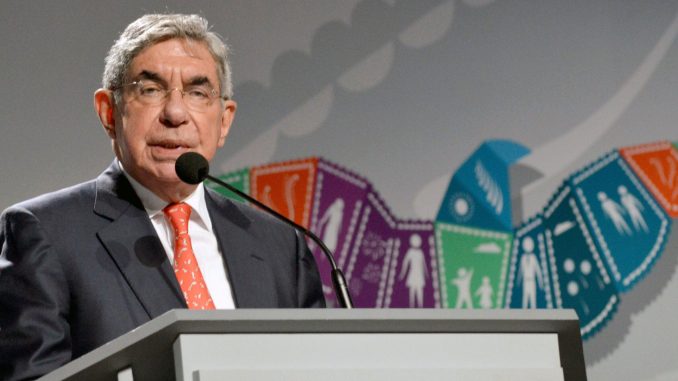
The nations that have signed the Arms Trade Treaty are meeting this week in Geneva. In 2016, the Obama administration took the U.S. into the treaty. In 2019, the Trump administration took us out of it. The latter decision keeps on looking better and better.
In theory, the Arms Trade Treaty is about requiring nations to set up a system for controlling the export—and to an extent, the importation—of conventional weapons, from revolvers to battleships. In practice, however, it’s about pressuring democracies not to sell weapons to anyone the activists behind the treaty don’t like.
If you take the treaty on its own terms, the idea behind it was silly from the start. If a nation wants to control its arms exports, it can and will. It doesn’t need a treaty to give it that right. If it doesn’t want to control its arms exports, it won’t—and a treaty can’t and won’t make it.
In reality, therefore, the treaty isn’t a legal instrument; it’s a political one. It exists not to require nations to do something. It exists to create a way to pressure nations into doing something. It’s a tool in a struggle over policy, a car to allow the left to chase their favorite ambulance.
For a while, the left’s favorite villain was Israel. Now, thanks to the war in Yemen, it’s Saudi Arabia. What doesn’t change is the unwillingness of the left to criticize anyone but the United States and a few European arms exporters—and to ignore Russia, China, and Iran.
I treasure the memory of a leading treaty activist explaining that the downing of Malaysia Airlines Flight 17, shot down by a Russian surface-to-air missile over eastern Ukraine in 2014, was the fault of “today’s globalized environment.”
She couldn’t bring herself to blame the Russians.
At this point, almost a decade after the treaty was negotiated, no one’s even bothering to pretend that it’s working. One of the big talking points in 2014 was the need for a treaty to stop arms dealers such as Viktor Bout—portrayed by Nicolas Cage in the 2005 movie “Lord of War”—from running amok in Africa.
That, too, was nonsense: Bout wasn’t a free agent. He was working with the knowledge and backing of the Russian government. But now, the Biden administration wants to swap Bout, now in U.S. custody, for WNBA star Brittney Griner and former U.S. Marine Paul Whelan, both of whom are being held in Russia.
That tells you all you need to know about how much anyone cares about Bout. Now that he’s served his purpose and justified the treaty, Bout’s disposable.
But so is the treaty itself. Its own supporters point out that nations are increasingly not even filing the reports that the treaty supposedly mandates. These days, with more and more reports not showing up at all, no one even bothers to ask if the reports that are filed are actually accurate.
The U.S.’s response to Russia’s invasion of Ukraine illustrates why the Arms Trade Treaty is such a bad idea. After the Russian invasion, the Biden administration’s response was reportedly stalled by “legal questions” about whether it was legal to provide arms to the Ukrainians.
Fortunately, the determination to help Ukraine was bipartisan and nearly unanimous, so those legal questions didn’t amount to much (at least as far as we know). But this is precisely the kind of situation in which the Arms Trade Treaty could be a serious obstacle.
All it needs is for the U.S. to sign back onto the treaty, for another and more controversial crisis (say, a Chinese threat to Taiwan) to kick off, and for a few lawyers on the National Security Council to start raising objections, and the U.S.’s ability to export arms could be kneecapped.
How could that happen? Well, a lot of the treaty’s most enthusiastic backers don’t like the U.S. arming Ukraine. And one of the requirements of the treaty is that exporters are supposed to assess whether their arms would be used in “attacks directed against civilian objects or civilians protected as such.”
And wouldn’t you know it—Amnesty International recently published a report, “Ukraine: Ukrainian Fighting Tactics Endanger Civilians.” It was a shoddy piece of work and was immediately condemned by the United Kingdom’s Royal United Services Institute, and it led to the resignation of the head of Amnesty’s Kyiv branch.
On the other hand, the Russians loved it, with the Russian Embassy in London tweeting that “@Amnesty confirms #Ukraine tactics violate international humanitarian law & endanger civilians. … [E]xactly what #Russia has been saying all along. #StopNaziUkraine.”
That’s proof enough of Amnesty’s folly.
But with Amnesty coming out against Ukraine—and therefore, tacitly, on the side of the Russians—it’s now possible for any clever left-wing lawyer who didn’t like the U.S.’s arms transfers to Ukraine to begin with to claim that those transfers are being used in “attacks directed against civilian objects,” and thus that those transfers are banned under the treaty.
That’s what I mean when I say that the treaty is a way to dress up policy arguments in legal clothes. If you want to ignore Amnesty, you can (and you should).
But if you don’t want to, or you don’t understand their sophistry, or you don’t care to figure it out, or you’re on the fence—well then, a legal argument based on the treaty, supplemented by an Amnesty report, could sound pretty persuasive.
The treaty was fundamentally flawed from the beginning. It was never going to have any influence on regimes like that of Russian President Vladimir Putin. It was always going to focus on the democracies. The world is a tough enough place as it is without treaties that give dictatorships an edge.
Have an opinion about this article? To sound off, please email letters@DailySignal.com and we’ll consider publishing your edited remarks in our regular “We Hear You” feature. Remember to include the url or headline of the article plus your name and town and/or state.

